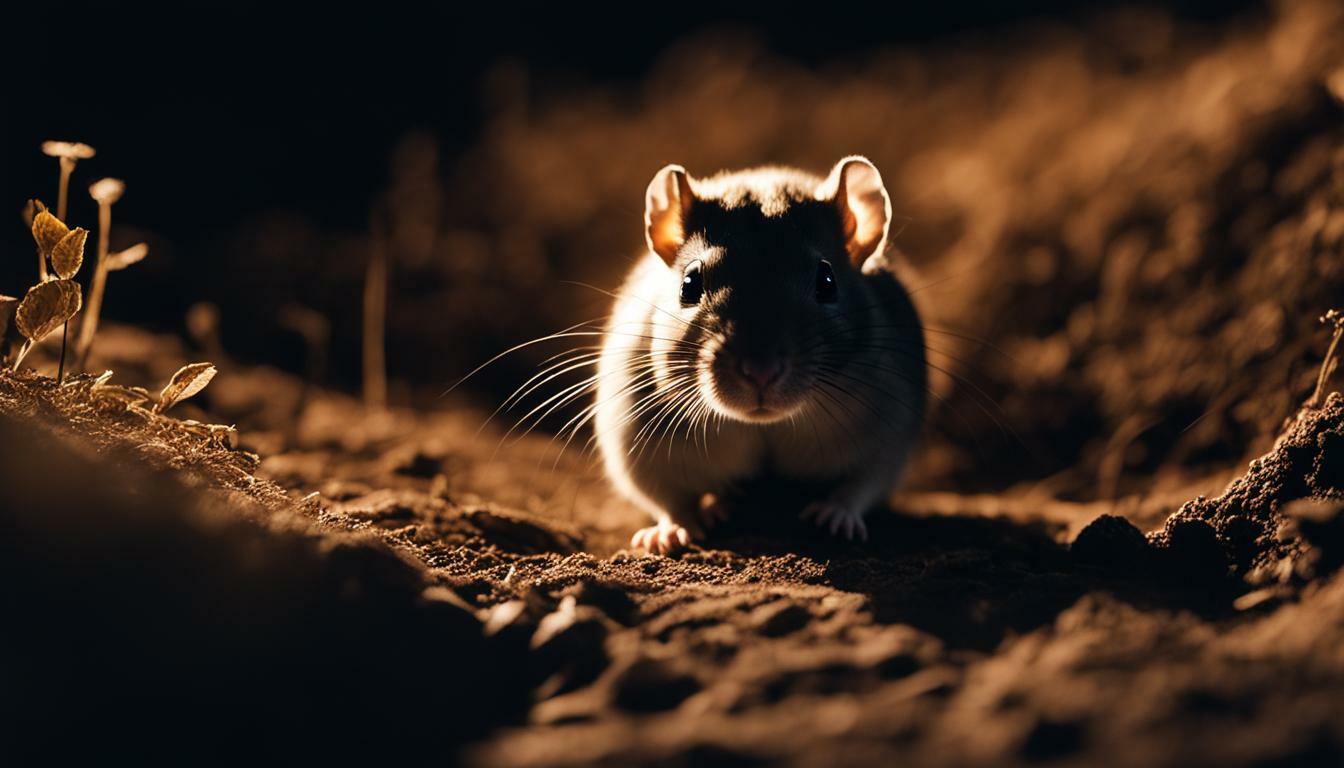Gerbils are known for their ability to see in the dark, but how well can they actually navigate in low light? In this article, we will explore the fascinating world of gerbil vision and shed light on their night-time abilities.
Key Takeaways:
- Gerbils have good night vision and can navigate in low light conditions.
- Their eyes are adapted for seeing in the dark, with a high proportion of rod cells.
- Gerbils are diurnal by nature but can adjust their activity patterns to match their owner’s sleep schedule.
- They rely on senses other than sight, such as smell and touch, to find their way around in the dark.
- Leaving a light on for gerbils at night is unnecessary and can disrupt their natural sleep cycle.
Understanding Gerbil Vision
Gerbils have a unique visual system that allows them to see relatively well in the dark, thanks to the high proportion of rod cells in their eyes. These rod cells are highly sensitive to light and are responsible for their night vision capabilities. Unlike cone cells, which are responsible for color vision and work best in bright light, rod cells are designed to function in low light conditions.
Because of their nocturnal nature, gerbils have evolved to rely more on their rod cells for vision. This adaptation allows them to navigate their surroundings even when light levels are low. While gerbils may not have the same level of visual acuity in the dark as they do in daylight, their rod cells enable them to have a reasonable level of vision in dim light.
In addition to having a high proportion of rod cells, gerbils also have a layer of tissue called the tapetum lucidum behind their retina. This tissue reflects light back through the retina, enhancing their night vision abilities. It acts like a mirror, increasing the amount of light that reaches the rod cells and improving their sensitivity to low light conditions.
Role of Rod Cells in Gerbil Vision
The rod cells in gerbils’ eyes are responsible for their ability to see in the dark. These cells contain a pigment called rhodopsin, which is extremely sensitive to light. When an animal enters a dark environment, the rhodopsin molecules in the rod cells become activated, allowing them to respond to even the smallest amount of light. This process helps gerbils detect movement and shapes, allowing them to navigate their surroundings with relative ease.
The high proportion of rod cells in gerbils’ eyes is what sets them apart from other diurnal animals. While many diurnal creatures, such as humans, have a higher ratio of cone cells for better color vision in bright light, gerbils prioritize their night vision capabilities by having more rod cells. This adaptation allows them to thrive in their natural nocturnal habitat and find their way around even when the lights are low.
| Proportion of Rod Cells | Proportion of Cone Cells |
|---|---|
| High | Low |
With their unique visual system and enhanced night vision abilities, gerbils are well-equipped to navigate in low light conditions. While they may not see as clearly as they do during the day, their reliance on rod cells and the presence of the tapetum lucidum enable them to see relatively well in the dark.
Gerbils’ Nocturnal Nature
While gerbils are diurnal by nature, they also exhibit nocturnal behavior and can make use of their night vision to navigate in dimly lit environments. This means that they are most active during the night when their surroundings are darker and less illuminated. It is during these nighttime hours that gerbils rely on their excellent night vision to move around and explore their surroundings.
Gerbils’ nighttime vision is aided by their eyes, which are equipped with a high proportion of rod cells. These rod cells are highly sensitive to low levels of light and allow gerbils to see relatively well in the dark. Although they may not have the same visual acuity as some nocturnal animals, gerbils still have the ability to discern shapes and objects even in dimly lit conditions.
While their vision is certainly an advantage, gerbils also have other senses that help them navigate in the dark. Their sense of smell is particularly acute, allowing them to detect food, predators, and other gerbils even in the absence of sufficient lighting. Additionally, gerbils rely on their sense of touch to navigate their surroundings, using their whiskers and sensitive paws to feel their way around obstacles and explore their environment.
| Gerbils’ Nocturnal Nature | Summary |
|---|---|
| Gerbils are diurnal by nature | They exhibit nocturnal behavior |
| They have excellent night vision | Can navigate in dimly lit environments |
| High proportion of rod cells in their eyes | Allows them to see relatively well in the dark |
| Acute sense of smell | Helps them detect food, predators, and other gerbils |
| Reliance on sense of touch | Use whiskers and paws to feel their way around |
Contrary to popular belief, it is not necessary to leave a light on for gerbils at night. In fact, doing so can disrupt their natural sleep cycle and cause unnecessary stress. Gerbils are not afraid of the dark and have evolved to thrive in low light conditions. By allowing them to live in a natural environment without artificial lighting, you are providing them with the optimal conditions for their well-being.
Gerbils’ Senses in the Dark
In addition to their impressive night vision, gerbils rely on their other senses, such as smell and touch, to navigate in the dark. While their eyes are well-adapted for seeing in dim light, gerbils also have a heightened sense of smell, which helps them find their way around their environment. Their keen sense of smell allows them to detect familiar scents and locate food sources even in the absence of sufficient lighting.
Gerbils also make use of their sensitive whiskers and tactile sense to navigate in the dark. These tiny rodents have long whiskers that enable them to sense and detect objects and boundaries in their surroundings. By brushing against walls and other objects, gerbils can determine the layout of their environment and avoid potential obstacles.
While gerbils can see relatively well in dim light, it is important to note that their vision may still have limitations in complete darkness. Like most animals, gerbils may struggle to see in pitch-black conditions where there is no ambient light available. However, their keen senses of smell and touch compensate for any limitations in their vision, allowing them to confidently explore their surroundings even when it’s dark.
| Gerbils’ Senses in the Dark |
|---|
| Impressive Night Vision |
| Keen Sense of Smell |
| Sensitive Whiskers and Tactile Sense |
In conclusion, gerbils have excellent night vision and can navigate in low light conditions. Their eyes, with a high proportion of rod cells, allow them to see relatively well in the dark. However, they also rely on their other senses, such as smell and touch, to confidently explore and navigate their environment. Therefore, there is no need to leave a light on for gerbils at night, as it can disrupt their natural sleep cycle. By understanding and appreciating their unique sensory abilities, we can ensure that gerbils thrive in their nocturnal habitats.
Gerbils and Artificial Lighting
Contrary to popular belief, gerbils do not require artificial lighting at night, as it can disrupt their natural sleep patterns. Gerbils have evolved to be active during the night, relying on their excellent night vision to navigate in low light conditions. They possess a high number of rod cells in their eyes, which are specially adapted for detecting movement and light intensity in dimly lit environments.
Instead of relying solely on their vision, gerbils have developed heightened senses of smell and touch to help them find their way around in the dark. Their sense of smell allows them to detect familiar scents and navigate their surroundings, while their sensitive whiskers help them to sense objects and obstacles in their path. These sensory adaptations make gerbils highly capable of functioning in the dark without the need for artificial lighting.
Despite their nocturnal nature, some gerbils may adjust their activity patterns to match their owner’s sleep schedule. This means they may be more active during the day and sleep for longer periods at night. However, it is important to note that gerbils are not afraid of the dark and can function perfectly well without any light source.
Providing a consistent dark environment for gerbils during their natural sleep cycle is crucial for their overall well-being. Exposure to artificial light at night can disrupt their sleep patterns and lead to stress and confusion. It is recommended to keep the room where gerbils are housed in a quiet and peaceful setting during nighttime hours, allowing them to rest and recharge for their active periods during the night.
| Key Points | |
|---|---|
| Gerbils have excellent night vision due to a high proportion of rod cells in their eyes. | Gerbils rely on their senses of smell and touch to navigate in the dark. |
| Gerbils are not afraid of the dark and do not require artificial lighting at night. | Exposure to artificial light can disrupt gerbils’ natural sleep patterns. |
Adjusting to Sleep Schedule
Gerbils are known for their ability to adjust their activity patterns to match their owner’s sleep schedule, making them adaptable pets. While gerbils are generally diurnal animals, meaning they are most active during the day, some gerbils may naturally shift their active periods to the nighttime hours. This flexibility in their behavior allows them to bond with their owners and participate in activities during waking hours.
It’s important to note that not all gerbils will adjust to a nocturnal schedule, as individual preferences can vary. Some gerbils may remain primarily active during the day, while others may switch to a more nocturnal routine. This can be influenced by various factors, such as the owner’s schedule, the gerbil’s environment, and their natural instincts.
When considering adjusting your gerbil’s sleep schedule, it’s essential to provide them with a suitable environment. This includes ensuring they have a quiet and comfortable space to rest during the day, as well as providing enriching activities for their active periods. Creating a consistent routine and providing ample mental and physical stimulation can help encourage a smooth adjustment to a new sleep schedule.
Remember, gerbils are highly adaptable creatures, and with proper care and attention, they can thrive in a variety of sleep schedules. Observing their natural behavior, providing a conducive environment, and offering engaging activities will contribute to their overall well-being and happiness.
| Gerbil Activity Patterns | Owner’s Sleep Schedule |
|---|---|
| Diurnal (Daytime) | Gerbil and owner are active during the day |
| Nocturnal (Nighttime) | Gerbil and owner are active during the night |
| Crepuscular (Dawn and Dusk) | Gerbil and owner have overlapping active periods in the morning and evening |
Gerbils and Darkness
While gerbils have impressive night vision, they, like most animals, cannot see in complete darkness. Their eyes are adapted to low light conditions, allowing them to navigate their surroundings with relative ease. Gerbils have a high proportion of rod cells in their eyes, which are responsible for detecting light and movement. These rod cells are more sensitive to light than the cone cells that function in bright light, making gerbils well-suited for activities in dimly lit environments.
Although gerbils are diurnal by nature, meaning they are most active during the day, they are not afraid of the dark. In fact, many gerbils will adjust their activity patterns to match their owner’s sleep schedule and be more active during the night. They rely on their senses other than sight, such as their keen sense of smell and touch, to navigate their surroundings in the absence of sufficient lighting.
It is important to note that leaving a light on for gerbils at night is unnecessary and can disrupt their natural sleep cycle. Gerbils need a period of darkness for proper rest and rejuvenation. Providing a consistent dark environment will help maintain their overall well-being. So, instead of keeping the lights on, you can ensure that your gerbil’s habitat is safe and comfortable by providing hiding spots, toys, and appropriate bedding materials that will help them feel secure in the dark.
| Gerbil Vision in Low Light | Gerbil Eyesight in the Dark | Can Gerbils See in Complete Darkness |
|---|---|---|
| Impressive | Adapted for low light conditions | No, they cannot |
In summary, gerbils have good night vision and can navigate in the dark thanks to their specialized eyesight. They are not afraid of the darkness and can rely on their other senses to find their way around. Remember, it is best to provide a dark and comfortable environment for your gerbil to ensure their well-being and natural behavior.
Conclusion
In conclusion, gerbils have excellent night vision and can see relatively well in the dark, thanks to their unique visual adaptations. With a high proportion of rod cells in their eyes, gerbils have the ability to navigate in low light conditions with ease. While they are primarily diurnal creatures, some gerbils may adjust their activity patterns to match their owner’s sleep schedule, remaining active during the day if necessary.
Gerbils are not afraid of the dark and rely on their other senses, such as their sense of smell and touch, to find their way around. These heightened senses allow them to navigate and explore their surroundings even in the absence of sufficient lighting. It is worth noting that leaving a light on for gerbils at night is unnecessary and may disrupt their natural sleep cycle.
So, rest assured that your gerbil is perfectly capable of seeing in the dark and does not require any artificial lighting. Their night vision, combined with their other senses, allows them to adapt and thrive in dimly lit environments. Embrace their natural nocturnal behavior and create a peaceful and comfortable environment for your furry friend. Let them explore and play in the dark, just as they would in their natural habitat.
FAQ
Can gerbils see in the dark?
Yes, gerbils have good night vision and can see relatively well in low light conditions. They have a high proportion of rod cells in their eyes, which contribute to their ability to see in the dark.
How do gerbils navigate in the dark?
Gerbils rely on their senses of smell and touch to find their way around in the dark. While they primarily use their vision during the day, their heightened senses help them navigate in low light conditions.
Is it necessary to leave a light on for gerbils at night?
No, it is not necessary to leave a light on for gerbils at night. In fact, artificial lighting can disrupt their natural sleep cycle. Gerbils are not afraid of the dark and can function well without a light source.
Are gerbils nocturnal?
Gerbils are diurnal by nature, which means they are most active during the day. However, some gerbils can adjust their activity patterns to match their owner’s sleep schedule and be more active during the night.
Can gerbils see in complete darkness?
While gerbils have good night vision, their vision is not effective in pitch-black conditions. Just like most animals, gerbils need at least some level of light to see their surroundings.




